Centers of worship
The Longobard religiousness has left us numerous “footprints” in the form of historiographic material and historical memory.
The Route enables the smooth inclusion of ecclesiastical buildings and places of worship of the Longobard era as privileged stops along the same Route. A first census enabled the identification of 182 religious buildings, scattered across a wide area covering 17 Italian regions.
Notably, the Longobard era saw particular attention being devoted to sacred places and places of worship by the highest ranking clergy and nobility as well as by the people at large. This was testified – once again – by the Sanctuary of Monte Sant’Angelo, owing to the extraordinary attractiveness of the figure of St. Michael Archangel, the commander of the Lord’s army, holding a sword in his hand, as had done their ancient Norse god Wotan and owing to the high symbolic value the Longobards attributed to the weapon.
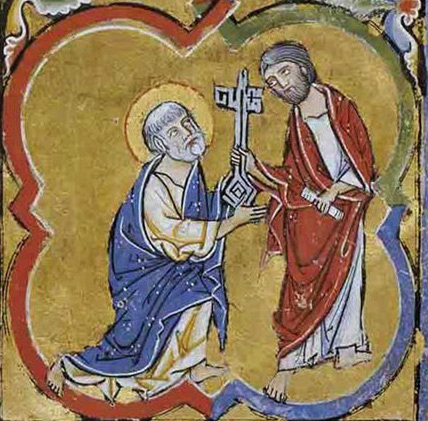
Ubi Petrus ibi Ecclesia
The worship of St. Michael Archangel spread everywhere – Italy included – and many new churches and places of worship were dedicated to the saint. The attractiveness of St. Michael Archangel brought about heavy pilgrimage flows from as early as 7thcentury A.D., which is unequivocally testified by the graffiti carved by distinguished figures in the shrine of Monte Sant’Angelo and by the tratturi (broad paths) linking the places were St. Michael was worshipped along transhumance routes. The paths were followed not only by shepherds but also by a larger number of believers.
In this regard, UNESCO made some interesting points about the development of the Criteria warranting the inclusion of the serial site “The Longobards in Italy. The centres of power (568-774) in the World Heritage List.
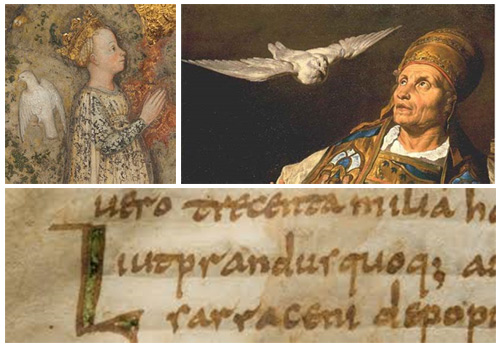
Longobards and Catholicism - Theodelinda and Pope Gregory the Great who started the conversion, inspiring the laws of Liutprando
«The places of the Longobards and their heritage in the spiritual and cultural structures of medieval European Christianity is very important. They considerably reinforced the monastic movement and contributed to the establishment of a forerunner venue for the great pilgrimages, in Monte Sant'Angelo, with the spread of the worship of St Michael. They also played an important role in the transmission of literary, technical, architectural, scientific, historical and legal works from Antiquity to the nascent European world».
The lofty project for culture and civilization was testified – inter alia – by the unifying vision of Theodelinda, the first Longobard queen of Italy, who laid the foundations of the nucleus of the Monza cathedral, build on the original sacellum (small shrine).
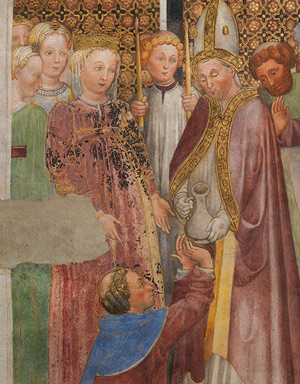
Il diacono Giovanni, dopo aver ricevuto doni da papa Gregorio Magno, li consegna all'arciprete di Monza alla presenza di Teodolinda.
Monza, Cappella di Teodolinda - ©Museo e Tesoro del Duomo di Monza/ph: Piero Pozzi
Equally significant is the Sanctuary of Monte Sant’Angelo on mount Gargano, where the Pagan worship of Wotan was replaced by the worship of St. Michael Archangel, originating from Eastern Christianity: a major centre for Christian worship, which continues to be an important pilgrimage destination today and which inspired the construction of equally well-known Mont Saint-Michel in France.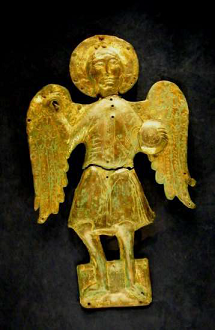
St Michael the Archangel
Other prestigious religious buildings belonging to the artistic and monumental heritage are considered extremely important, namely those included in the serial site “The Longobards in Italy, the centres of power (568-774 A.D.)”: the Tempietto longobardo (literally: the little Longobard Temple) in Cividale, the Church of S. Salvatore in Brescia; the Church of S. Salvatore in Spoleto and the Clitunno Tempietto in near-by Campello; the Santa Sofia complex in Benevento, build by order of prince Arechi II as the national sanctuary of the Longobards of the South. The list is joined by numerous churches in Pavia, most notably the renovated Church of S. Pietro in Ciel d’Oro (St. Peter in the Golden Sky), to which the remains of St. Augustine were transferred and where the saint was finally buried by order of king Liutprand and a number of royal foundations of the principalities of Salerno and Capua.
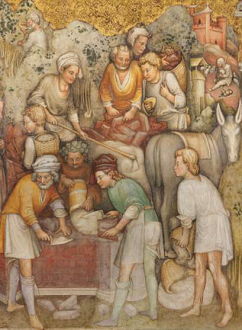
Fondazione del Duomo di Monza
Monza, Cappella di Teodolinda - ©Museo e Tesoro del Duomo di Monza/ph: Piero Pozzi
Other sites deserve to be on the long list, namely the churches and especially the monasteries – which were converted into abbeys at a later stage – founded by Longobard kings, dukes and aristocrats, where masterpieces of classical antiquity are kept and where fundamental research activities were promoted: the abbeys of Bobbio (founded by St. Columbanus upon authorization of Agilulfo and Theodelinda), Nonantola, Montecassino (first destroyed then reconstructed by the Longobards), Cava de’ Tirreni, Sesto al Reghena, Abbadia di San Salvatore, Leno and S. Vincenzo al Volturno among others.
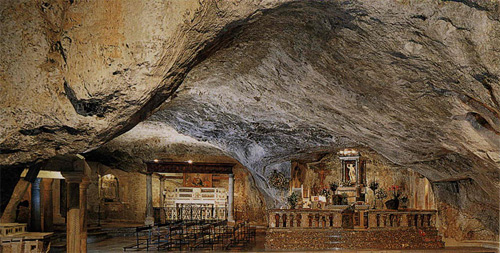
Monte Sant'Angelo - Grotta Santuario di San Michele Arcangelo
Mention should also me made of other precious examples of architecture of the Early Middle Ages, to be admired almost everywhere in Italy and areas prepared for religious rituals discovered in the grotto sanctuaries of Matera and the Salerno and Calabro-Lucan areas.
ANNEX
The patron Saints of the Longobards
News
-
2025 24 SeptemberTra le carte della Corona
-
2025 24 SeptemberLa religiosità dei Longobardi
-
2025 21 MarchERRATA CORRIGE CONVEGNO DONNE LONGOBARDE
